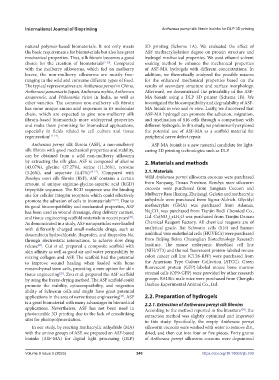Page 248 - IJB-9-5
P. 248
International Journal of Bioprinting Antheraea pernyi silk fibroin bioinks for DLP 3D printing
natural polymer-based biomaterials. It not only meets 3D printing (Scheme 1A). We evaluated the effect of
the basic requirements for biomaterials but also has great ASF methacryloylation degree on protein structure and
mechanical properties. Thus, silk fibroin becomes a good hydrogel mechanical properties. We used ethanol solvent
choice for the creation of biomaterials [7-10] . Compared soaking method to enhance the mechanical properties
with the mulberry silkworms, which fed on mulberry of ASF-MA hydrogels with different concentrations. In
leaves, the non-mulberry silkworms are mostly free- addition, we theoretically analyzed the possible reasons
ranging in the wild and consume different types of food. for the enhanced mechanical properties based on the
The typical representatives are Antheraea pernyi in China, results of secondary structure and surface morphology.
Antheraea yamamai in Japan, Antheraea mylita, Antheraea Afterward, we demonstrated the printability of the ASF-
assamensis, and Philosamia ricini in India, as well as MA bioink using a DLP 3D printer (Scheme 1B). We
other varieties. The common non-mulberry silk fibroin investigated the biocompatibility and degradability of ASF-
has some unique amino acid sequences in its molecular MA bioink in vivo and in vitro. Lastly, we discovered that
chain, which are expected to give non-mulberry silk ASF-MA hydrogel can promote the adhesion, migration,
fibroin-based biomaterials more widespread properties and myelination of S16 cells through a comparison with
and make them promising for biomedical applications, different hydrogels. In this study, we preliminarily explored
especially in fields related to cell culture and tissue the potential use of ASF-MA as a scaffold material for
regeneration [11-14] . peripheral nerve defect repair.
Antheraea pernyi silk fibroin (ASF), a non-mulberry ASF-MA bioink is a new material candidate for light-
silk fibroin with good mechanical properties and stability, curing 3D printing technologies such as DLP.
can be obtained from a wild non-mulberry silkworm
by extracting the silk glue. ASF is composed of alanine 2. Materials and methods
(43.07%), glycine (27.27%), serine (11.26%), tyrosine
(5.26%), and aspartate (4.47%) [15-17] . Compared with 2.1. Materials
Bombyx mori silk fibroin (BSF), ASF contains a certain Wild Antheraea pernyi silkworm cocoons were purchased
amount of unique arginine-glycine-aspartic acid (RGD) from Nanyang, Henan Province. Bombyx mori silkworm
tripeptide sequence. The RGD sequence was the binding cocoons were purchased from Jiangnan Cocoon and
site for cellular integrin receptors which could effectively Mulberry Base (Jiaxing, Zhejiang). Gelatin and methacrylic
promote the adhesion of cells to biomaterials [18,19] . Due to anhydride were purchased from Sigma-Aldrich. Glycidyl
its good biocompatibility and mechanical properties, ASF methacrylate (GMA) was purchased from Adamas.
has been used in wound dressings, drug delivery carriers, Na CO was purchased from Tianjin Bodi Chemical Co.,
3
2
and tissue engineering scaffold materials in recent years . Ltd. Ca(NO ) •4H O was purchased from Tianjin Damao
[20]
2
3 2
As demonstrated in a study, ASF nanoparticles were loaded Chemical Reagent Factory. All chemical reagents are of
with differently charged small-molecule drugs, such as analytical grade. Rat Schwann cells (S16) and human
doxorubicin hydrochloride, ibuprofen, and ibuprofen-Na, umbilical vein endothelial cells (HUVECs) were purchased
through electrostatic interactions, to achieve slow drug from Beijing Beina Chuanglian Biotechnology Research
release . Cui et al. prepared a composite scaffold with Institute. The mouse embryonic fibroblast cell line
[21]
skin affinity as well as good air and water permeability by (NIH/3T3) and the red fluorescent protein-labeled mouse
mixing collagen and ASF. The scaffold had the potential colon cancer cell line (CT26-RFP) were purchased from
to improve wound healing when loaded with bone the American Type Culture Collection (ATCC). Green
mesenchymal stem cells, providing a new option for skin fluorescent protein (GFP)-labeled mouse bone marrow
tissue engineering . Zou et al. prepared the ASF scaffold stromal cells (OP9-GFP) were provided by other research
[22]
by using the freeze-drying method. The ASF scaffold could groups. BALB/c male mice were purchased from Chengdu
promote the viability, cytocompatibility, and migration Dashuo Experimental Animal Co., Ltd.
ability of Schwann cells and might have great potential
applications in the area of nerve tissue engineering . ASF 2.2. Preparation of hydrogels
[23]
is a great biomaterial with many advantages in biomedical 2.2.1. Extraction of Antheraea pernyi silk fibroins
applications. Nevertheless, ASF has not been used in According to the method reported in the literature , the
[24]
photocurable 3D printing due to the lack of crosslinking extraction method was slightly optimized and improved
sites for photopolymerization.
in this study. Specifically, the empty Antheraea pernyi
In our study, by reacting methacrylic anhydride (MA) silkworm cocoons were washed with water to remove dirt,
with the amino groups of ASF, we prepared an ASF-based dried, and then cut into four or five pieces. Forty grams
bioinks (ASF-MA) for digital light processing (DLP) of Antheraea pernyi silkworm cocoons were degummed
Volume 9 Issue 5 (2023) 240 https://doi.org/10.18063/ijb.760

